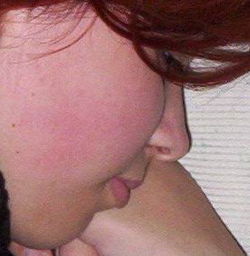- Cheek
-
This article is about the anatomical feature. For other uses, see Cheek (disambiguation).
Cheek 
Girl with prominent (puffy) cheeks. Latin bucca Artery buccal artery Nerve buccal nerve, buccal branch of the facial nerve MeSH Cheek Cheeks (Latin: buccae) constitute the area of the face below the eyes and between the nose and the left or right ear. They may also be referred to as jowls. "Buccal" means relating to the cheek. In humans, the region is innervated by the buccal nerve. The area between the inside of the cheek and the teeth and gums is called the buccal pouch or buccal cavity and forms part of the mouth.
Cheeks are fleshy in humans[1] and other mammals, the skin being suspended by the chin and the jaws, and forming the lateral wall of the human mouth, visibly touching the cheekbone below the eye. Some animals such as squirrels and hamsters use the buccal pouch to carry food or other items.
In vertebrates, markings on the cheek area (malar stripes/spots/...), particularly immediately beneath the eye, often serve as important distinguishing features between species or individuals.
The inside of the cheek is lined with a mucous membrane (buccal mucosa, part of the oral mucosa). It is the most common location from which a DNA sample can be taken (during a cheek swab).
The cheeks are covered externally by hairy skin, and internally by stratified squamous epithelium. This is mostly smooth, but may have aborally directed papillae (e.g.: ruminants). The mucosa is supplied with secretions from the Buccal glands, which are arranged in superior and inferior groups. In carnivores, the superior buccal gland is large and discrete: the Zygomatic gland. During mastication (chewing), the cheeks and tongue between them serve to keep the food between the teeth.
See also
- Blushing
- Cheek augmentation
- Erythema infectiosum
- Tongue-in-cheek
- Zygomatic bone
- Cheek kissing
References
Human regional anatomy (TA A01.1) Head 
Neck Trunk Limbs Lower limb/
(see also leg)General anatomy: systems and organs, regional anatomy, planes and lines, superficial axial anatomy, superficial anatomy of limbsHead and neck anatomy, digestive system: Mouth anatomy (TA A05.1–2, TH H3.04.01, GA 11.1110–2, 1125–1141) Mouth Lip (Upper, Lower, Vermilion border, Frenulum of lower lip, Labial commissure of mouth, Philtrum)
Cheek (Buccal fat pad)Interdental papilla · Gingival sulcus · Gingival margin · Free gingival margin · Gingival fibers · Junctional epithelium · Mucogingival junction · Sulcular epithelium · Stippling
Periodontium: Cementum · Gingiva · Periodontal ligamentTeethsee tooth anatomydorsum (Taste bud, Median sulcus, Terminal sulcus, Foramen cecum, Lingual tonsils) · underside (Frenulum, Fimbriated fold, Sublingual caruncle) · Anterior · Posterior · Glossoepiglottic folds · Lingual septumOro-pharynx/
fauces
This anatomy article is a stub. You can help Wikipedia by expanding it.
